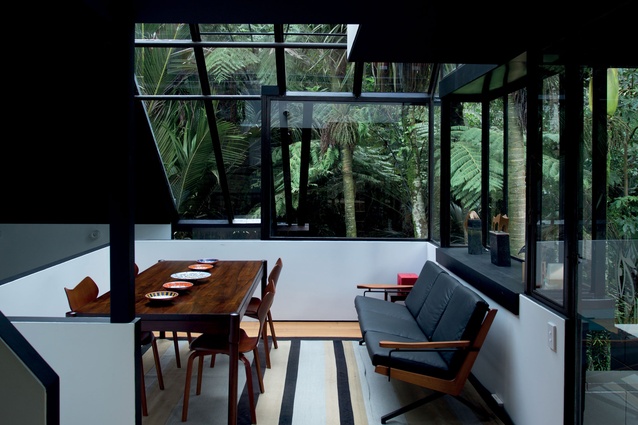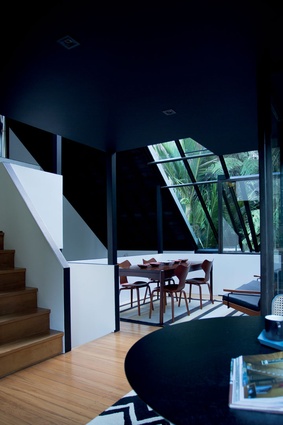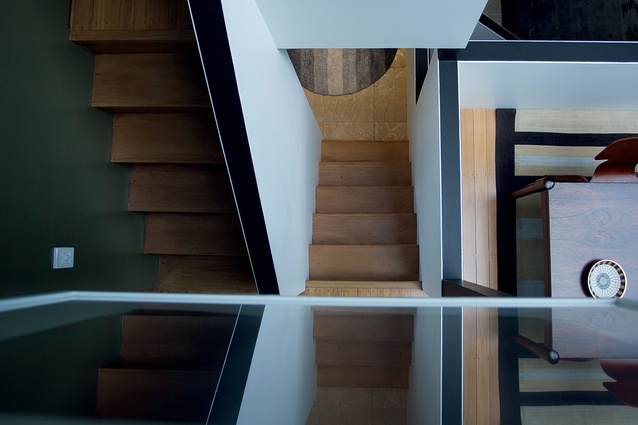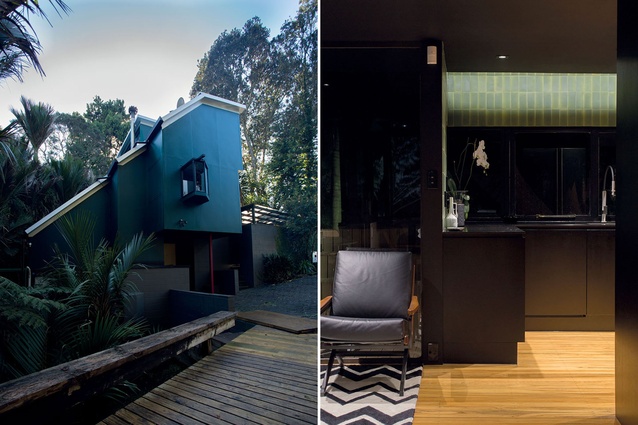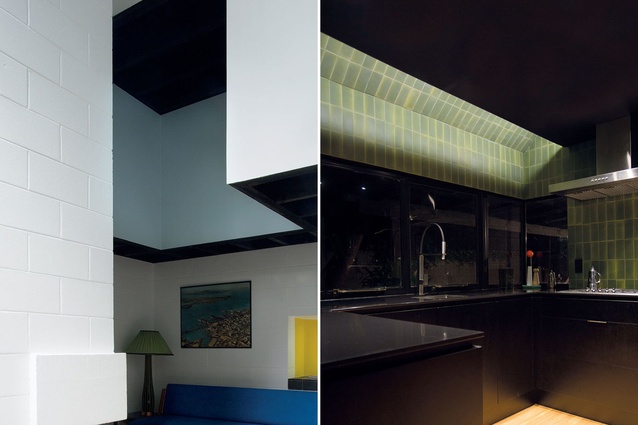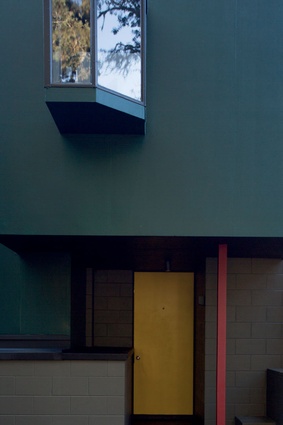Domestic ritual: The Green House
Lynda Simmons reflects on the work of Claude Megson and reviews Rafik Patel’s recent restoration of one of Megson’s 1970s’ designs, the Green House, on Auckland’s North Shore.
The recent restoration of a 1970s’ Claude Megson-designed house by AUT Spatial Design lecturer, Rafik Patel, displays an understanding of the strength of Megson’s work, while introducing some simple elements that bring clarity and calm to a (wonderfully) spatially complex interior.
This respectful re-invigoration brings a welcome focus to an era of work that has been out of favour for several decades – too many great 1970s’ houses have been demolished to make way for our most recent version of modernist revival. It is hoped that this reworking of a Megson classic, which had fallen into disrepair, will return an appreciation for our larrikin decade – with its economical interwoven spaces, social/behavioural focus and sharply angled forms.
The 1970s in New Zealand architecture is a decade known for its global counter-cultural influence; our source was mainly the west coast of the USA. New Zealand’s accepted architectural history locates Ian Athfield and Roger Walker at the centre of this anti-authoritarian era. It was a decade when traditions and authority were challenged and social restructuring was optimistic, despite the gloomy backdrop of the devalued New Zealand dollar, high unemployment rates and dawn raids.
The optimism took form in pursuits of social equity and, spatially, this meant the rise of communal living and a re-assessment of housing design – seen in self-sustaining mobile societies or established communes.
In addition to a rising awareness of environmentalism, handcrafted arts, social protest against wars, oil shortages and freer social structures, the 1970s is also the decade now recognised as the one during which the ultimate commune of all, the internet, was developed.1
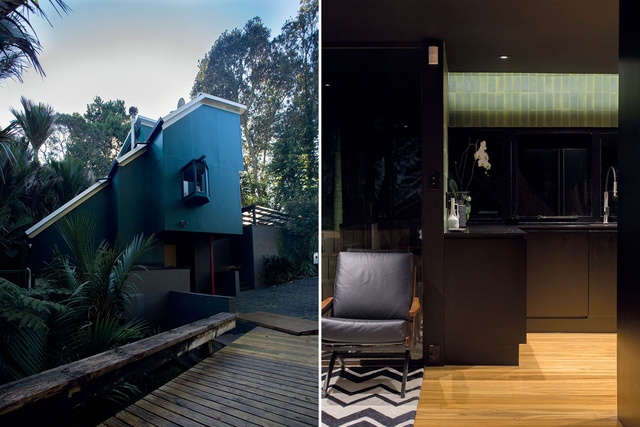
Auckland-based architect Claude Megson (1936–1994) was a strong figure of this era in relation to residential architecture; his architectural output and teaching influence as a staff member at The University of Auckland (1965–1992)2 were dominant at the time. He was a divisive figure at the university among both staff and students.
While his ‘master/disciple’ approach was not favoured by all in the decade intent on pulling apart traditional hierarchies, his passionate lectures are remembered fondly by many. His influence extends widely through several generations of graduates. Megson’s work was extraordinary in its inventiveness and exuberance, and he enjoyed the accolades of the time that paralleled his work in Auckland with the Wellington duo of Athfield and Walker. (Megson was awarded, published and exhibited at the time.)
As many have commented since,3 Megson’s presence has become less visible in our publications and our storytelling since the turn to postmodernism in the mid-1980s. When Dr John Dickson reviewed Megson’s work in 1992, he often referred to Megson as belonging to ‘his generation’, clearly suggesting that the architectural explorations of the 1970s had come to a close and a new generation was, by then, firmly in place.4 Claude Megson – Counter Constructions, a recent book by Giles Reid and Jackie Meiring, re-presents ‘Claude’ to a new generation, as does the recently restored ‘Green House’ by Rafik Patel.5
This home in Glenfield (originally the Phillips House, called also the ‘Green House’) received its building permit in 1977 and reveals many aspects typical to its era (small-scale spaces, periscope-style projections, a 45-degree sloped roof, centralised internal circulation around a core and elemental expression of the interior to create form) and is a very good example of what Megson brought to our architectural canon.
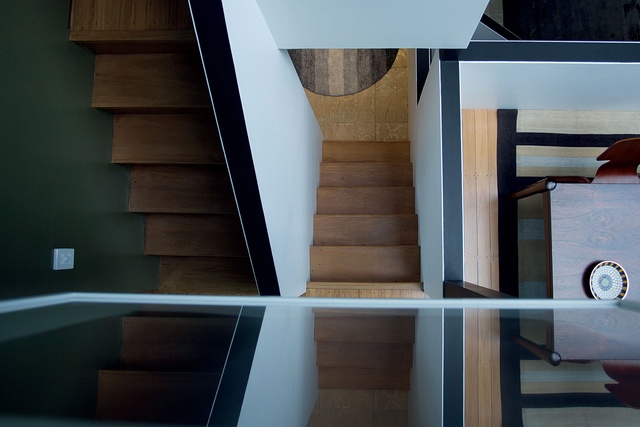
It is described in Block’s Itinerary No. 1 as a house which “…seems to be declining”;6 however, Patel has reversed that situation completely and has restored the entire structure and removed the infills, add-ons and styling it accumulated via prior owners. He has enhanced some central architectural ideas with his rereading of the house.
This sculptural house plays not with form as its matter, but with space. The many small components of space are interlinked horizontally and vertically over six and a half levels. While the plans are composed of intersecting square volumes, the experience of the vertically layered space is always via a diagonal view.7
Not only does the movement of the body itself experience this dynamic orientation (which can often be difficult thanks to the 45-degree short staircases!) but the space is ‘inhabited’ with the eye and the mind across many layers and in several directions from selected, carefully crafted positions of repose.
An example of this is the placement of the dining table, one favoured focus of domestic ritual by Megson. From the mid-level platform, the lower living room unfolds below, and the gaze tends upwards to the sloping, glazed roof and through openings into the bedroom zones. The adjacent kitchen is mainly hidden but conversation can continue via the interconnecting space, which also leads out into the landscape.
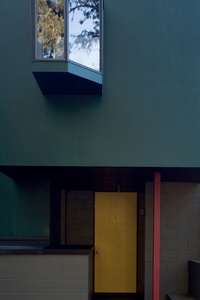
However, this physical description does nothing to convey the delight of changing light conditions from this position. From afternoon into evening, shadows held in niches and under projections seem to fold through the three-level void, as shafts of daylight shift and some artificial light moves in. Over time, a series of compositions plays out on a multi-surfaced background.
Megson took delight in the drama of light changing over time and contrasted the illuminated surfaces with gradually changing areas of shadow. In the renovation, Patel understands clearly how shadow is contained and enhanced throughout the niche spaces of the house, complementing and contrasting the light flooding through the singular, sloping, glazed roof.
Patel has made all ceiling surfaces black, providing a composition of floating black figures set in vertical space, against a sculpted, white, light-defined ground. He has reinstated a black line to the horizontal surface of each nib and half-height wall; this line also directs the eye around and through the complex spaces, and it has the effect of a sculpture in its own right, should it ever come loose from its wall and float.
‘Contained shadow’ is fully played out in the new kitchen, with the entire small space being treated as if it were a cave-like retreat, in all black. In contrast to the illuminated planes of the nearby living and dining areas, this retreat offers security and calm. Light is moderated along the green-tiled surfaces, bringing a soft ease to the gaze and connection to the adjacent landscape. Patel has established a personal, meditative space for cooking as opposed to a more typical social zone.
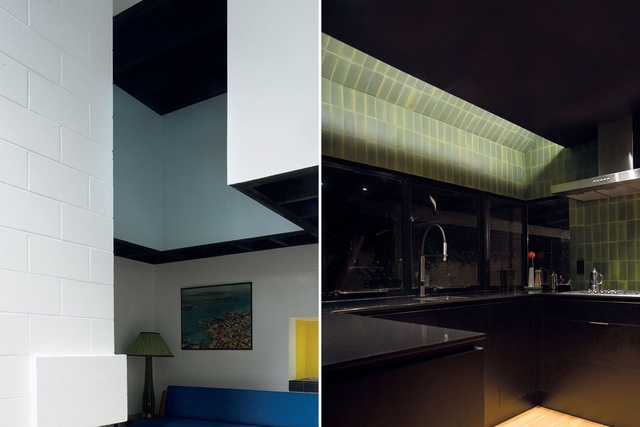
The dynamic of the centralised tall, glazed space is balanced through a series of adjacent constrained, small spaces – establishing interlinking personal and shared zones, typical of Megson’s approach to domestic living. Commonly in the 1970s, small-scaled domestic space was admired and, in his work, these personal, cave-like interiors (“the house should wrap the body like a cloak”) open quickly at the corners into shared, outward, spatial conditions.8
In this house, the diagonal view through atomised cubes of space is inescapable and the selection of photographer Andrew Lowe has been deliberate to obtain another possible rereading of the building. Lowe prioritises calm, symmetrical compositions and his images of this house manage to expose the removed corners of interconnecting spaces while avoiding the dynamic they set up.
Megson’s passion in both teaching and practice was to celebratethe ritual of daily life through domestic architecture, evidenced through his 1981 Study Paper, titled ‘The search for spatial meaning that clarifies and enriches human existence’, and his MArch thesis (1970).
This design approach illustrates a focus during the 1970s on sensory delight: a reaction to the post war modernism which dominated New Zealand in the 1950s and 1960s. Intimacy and social expression were again celebrated and Megson’s version, with his intense focus on domestic ritual, has been described as the “fetishising of domestic life”.9
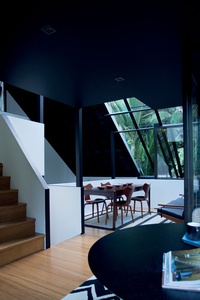
The lectures he gave at The University of Auckland are legendary for their images and passionate descriptions of extraordinary and ordinary domestic moments, and of the ways in which architecture can deliver to the everyday. They are also remembered for his personality; a large ego such as his was not usually admired in an era where ‘Kiwi modesty’ prevailed. It seems that his distinctly old-fashioned chauvinism (which some have experienced as misogyny), coupled with his out-of-date character, was not in tune with his contemporary work and ideas.
Like so many, I have a personal Claude memory of my own from when I attended a design course in a school holiday break in 1981 as a 7th form (Year 13) student. A lecture was given by Claude Megson and, to this day, his description of domestic life as ritual has infected my own ideas around how we design for daily living. I recall clearly his passionate treatise on design for dining, and the need for a tall space and a rich colour palette to celebrate and hold the energy which is generated through vigorous dining-table debate.
Despite his lecture drawing me to architecture school, I chose not to participate in his courses while a university student in the 1980s, because of his (by then very apparent) conservative views around women and their role in society. While this may have been my loss in an architectural education sense, I consider it more of a well-selected decision, which not only preserved my self-respect at the time but has enabled me to appreciate Megson’s work now, away from the personality.
Architecturally, Claude Megson fitted his era well – with brave and spatially exciting houses – yet, perhaps, he did not fit his time socially. Alongside the recent publication Claude Megson – Counter Constructions, this lovingly restored and re-imagined house by Rafik Patel will help revive interest in Megson’s work. Hopefully, more excellent work of the 1970s, by others as well, will be preserved from demolition and treated with the same care as that shown here.
1. Inaba, J, ‘Counterculture?’, Volume #24, Counterculture, 2010.
2. Megson taught part time at Auckland’s Architecture School from 1965 to 69 and full time between 1969 and 1992.
3. Barrie, A, Block Itinerary No.1, 2006. Cheshire, P, ‘Operation Megson. Pip Cheshire on the Search and Rescue of a Modern Romantic’, Block 03/04, 2017. Reid, G., ‘How the brilliant architecture of Claude Megson disappeared from view’, Paperboy/Noted, Nov 2017.
4. Dickson, J, Architecture NZ, July/Aug 1992, pp. 40–43.
5. Reid, G, Counter Constructions, 2016. As noted by many, referring to Megson by his first name seems more appropriate than by his last in articles such as these, as this is the way he was referred to in life.
6. Barrie, A, Block Itinerary No.1, 2006.
7. Reid, G, Counter Constructions, 2016. Reid analyses Megson’s work into four points: 1) Diagonal view to order space; 2) Tied to civilised landscape; 3) Exterior as an expression of the house; and 4) Ritual.
8. Such descriptions of space (‘open outward’) refer to Dr J Dickson’s Study Papers, ‘The Mastery of Space’, The University of Auckland, 1982.
9. Cheshire, P, Block 03/04, 2017.

